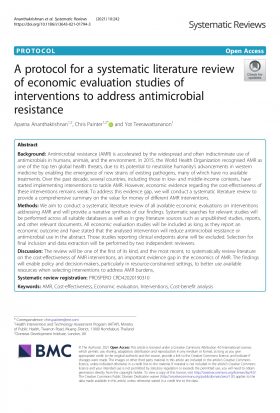This website uses cookies so that we can provide you with the best user experience possible. Cookie information is stored in your browser and performs functions such as recognising you when you return to our website and helping our team to understand which sections of the website you find most interesting and useful.
A protocol for a systematic literature review of economic evaluation studies of interventions to address antimicrobial resistance

รายละเอียดเพิ่มเติม
Abstract
Background
Antimicrobial resistance (AMR) is accelerated by the widespread and often indiscriminate use of antimicrobials in humans, animals, and the environment. In 2015, the World Health Organization recognised AMR as one of the top ten global health threats, due to its potential to neutralise humanity’s advancements in western medicine by enabling the emergence of new strains of existing pathogens, many of which have no available treatments. Over the past decade, several countries, including those in low- and middle-income contexts, have started implementing interventions to tackle AMR. However, economic evidence regarding the cost-effectiveness of these interventions remains weak. To address this evidence gap, we will conduct a systematic literature review to provide a comprehensive summary on the value for money of different AMR interventions.
Methods
We aim to conduct a systematic literature review of all available economic evaluations on interventions addressing AMR and will provide a narrative synthesis of our findings. Systematic searches for relevant studies will be performed across all suitable databases as well as in grey literature sources such as unpublished studies, reports, and other relevant documents. All economic evaluation studies will be included as long as they report an economic outcome and have stated that the analysed intervention will reduce antimicrobial resistance or antimicrobial use in the abstract. Those studies reporting clinical endpoints alone will be excluded. Selection for final inclusion and data extraction will be performed by two independent reviewers.
Discussion
The review will be one of the first of its kind, and the most recent, to systematically review literature on the cost-effectiveness of AMR interventions, an important evidence gap in the economics of AMR. The findings will enable policy and decision-makers, particularly in resource-constrained settings, to better use available resources when selecting interventions to address AMR burdens.




